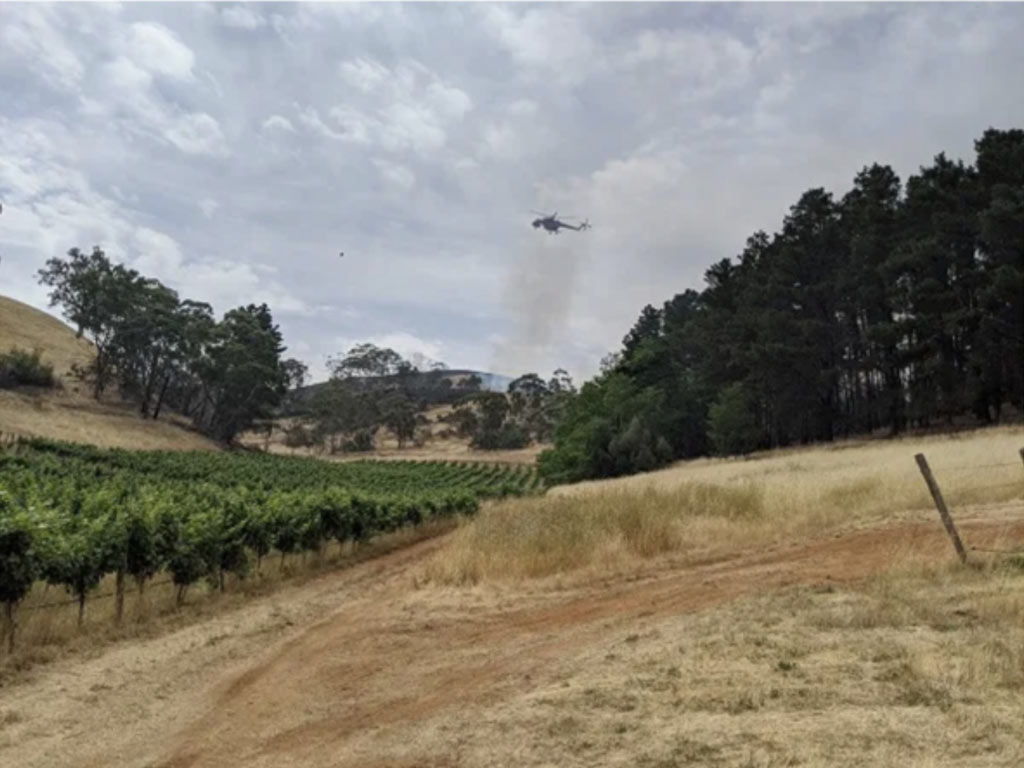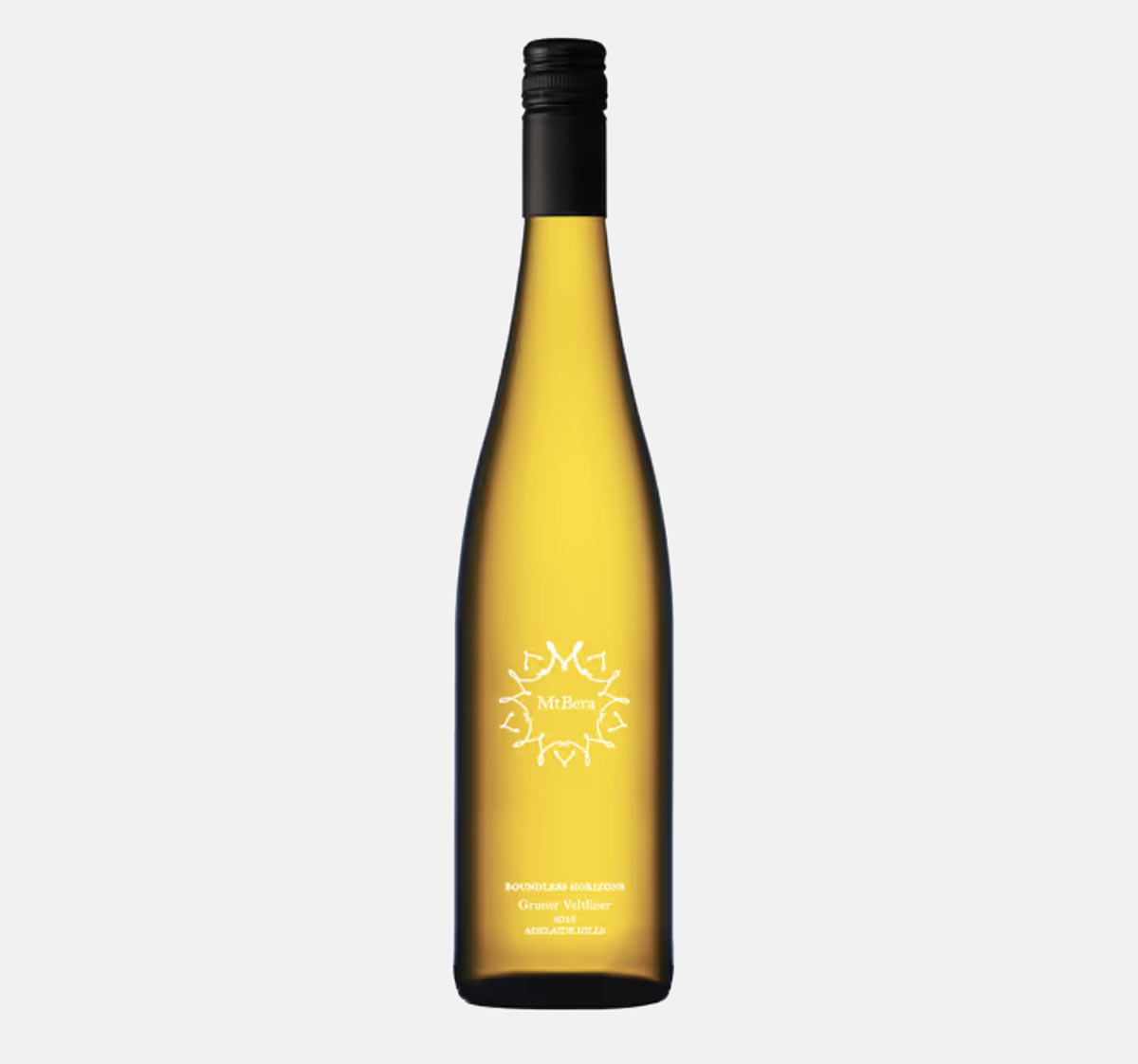Vineyard Recovery – Post Bushfire
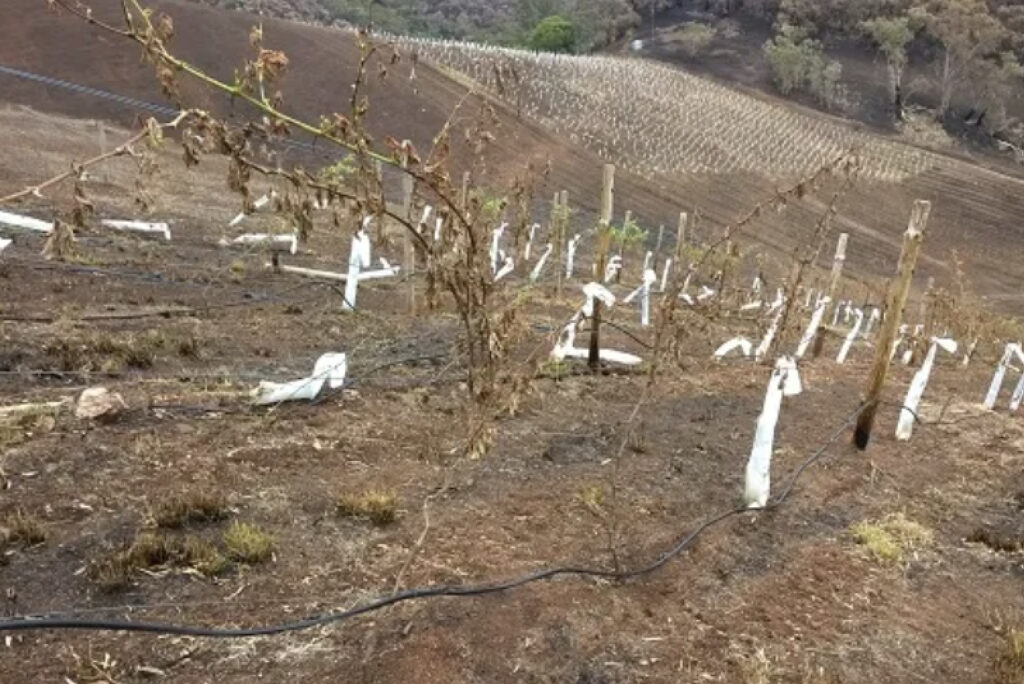
This has been written to give hope to Vineyard Owners and Operators who have been burnt out in the current round of bushfires. There is not a lot of useful information in the public domain about recovery from various levels of damage to vineyards. I hope this information helps provide practical experiences that will give other growers the ability to be able to make decisions about the plan for their burnt vineyards.
For anyone reading this who is looking to help those affected by bushfire, I would like to make the point that it is the primary producer who has all the risk, but who may not be visible to you. When the vineyards or other crops or farm land are burnt then their income is gone – maybe for several years depending on the damage. (For us the impact was enormous for a couple of years with no income, and then decreased income and lots of rebuilding expenses – so the debt mounts and is still there long after the fire is all but forgotten). If winemakers purchase grapes they may not be affected by fire in the same way as the grower – unless they grow all their own fruit to make into wine or have lost wine or other key assets. Everyone is affected in some way particularly when there is widespread fires but some people are really hurting. Supporting the whole area is a great thing to do, and buying wine from the area directly helps, but if you specifically would like to help the growers/farmers who have no visible market presence then look for a fund that will prioritise those people with the most significant impact. I am not sure what funds are operating in other areas of Australia, but in the Adelaide Hills Wine Region this link provides that https://www.adelaidehillswine.com.au/fireappeal
The Sampson Flat Bushfire started on the 2nd of January 2015 and burnt out an area over 20,000 hectares. Unfortunately for us at Mt Bera, the fire came from the North West through the conservation park, with enormous heat and completely ravaged the entire farm, including all our vineyards, and every fence on the place for stock. The only things not touched were the sheds and house which were well insured. Everything uninsured went up in smoke. The difficulty with insurance for production crops is the cost involved. We were losing money anyway and insuring what everyone said would not burn was causing financial grief. This situation appears to be very common after speaking with many growers from the Adelaide Hills that have been burnt this year.
Bushfire is extremely damaging and provides a massive emotional rollercoaster ride so knowledge of what to look for and useful information for decision making of burnt vineyards is important. Focus on small wins is needed in order to stay positive. Every shoot of green in the vines or the paddocks lifts your spirits and hope – moving away from the moonscape in black look, which is very disconcerting. Mt Bera is not just a vineyard but our home as well – so emotional, practical and financial issues had to be dealt with. Thanks go to our whole amazing family Katrina, Kali, Lily, Luka and Maya whose help was instrumental in rebuilding our entire property. Plus of course those individuals like Richard who works for us full time and never stops until the work is done (and who wakes during the night thinking about what is the next job – and whose peers have long since retired), and others who helped out during the rebuilding process.
Below there is a series of photos from each different vineyard. The important thing to note is that although our Mt Bera property is 75 Hectares we have 3 separate vineyards on different ridge/valley combinations. Due to the steep and varied topography we can grow a range of grapes that would not normally be grown so close to each other. One example is that the night time temperature in the Gruner Veltliner is 15 to 20 degrees cooler than 10 metres away where the Cab Sauv grows – due to the catchment of cool air dropping into the lower section of the valley before dropping down to the Torrens.
Each vineyard and variety had different issues. Some older vines. Some 2 months old. Some 15 months old. Some grafted vines. Some on the tops and windward side of the hill, and others on the leeward side. I will walk through the different scenarios.
Before I do I will give the ultra simple summary of what our experiences suggest to do.
- Don’t panic. Vines are weeds. The top can be completely nuked. The soil can be burnt down a foot deep. Our experiences tell us the vines will reshoot from the ground – some quicker than others, depending on where a bud can come from underground. It doesn’t matter if the vines are 2 months or 20 years old they will reshoot in our experience.
- Reshooting from the ground is preferable to anywhere else as the pipeline is clean and will have no restrictions.
- When you remove the old material is not so important – more a function of practicalities of when you can actually do it.
- Retraining of new shoots from the ground is an open question. We left all shoots growing that season – with no irrigation on anything except the very young vines. All shoots lignified and we chose the 2 best shoots to 2 bud. They shot very strongly and allowed us to have 2 thinner trunks for the second season after the fire to support an almost full crop. The current round of fires were about 3 weeks phenologically behind compared to our fire. Training passes this season may lead to the ability to have a crop in the first season after the fire. My gut feeling is there is an optimal amount of leaf area needed to get stored carbohydrates for the following season. (My only experience in this is when we planted young vines and tried to train too soon and ended up with weaker trunks in the vines we removed shoots from than the ones we left every shoot till winter – and it is all about timing – those we did early had stronger trunks and those a bit late in the season were weaker – this was only about 10 days different)
- Initial reaction for lots of people is that the vines are worse than they actually are. If they are shooting from the ground the vine is telling you the old top has had it. If they are shooting from the trunk then it has a partially burnt trunk, but if possible wait to get a shoot from the ground. If it is shooting from the cordon there is at least enough trunk function to do something. It may not be able to support a full crop but perhaps some crop is better than nothing whilst you retrain new shoots from the ground for following seasons – in a similar way to Eutypa treatment. My rule of thumb is that up to 50% of burnt trunk will most likely produce a full crop from the old cordon. Up to 75% can produce a signficant crop. Past that point and they tend to shoot but once you get a hot day the pipeline is just not big enough to support the canopy. If you look at the photo below of the Short Rows of Pinot Noir and compare to burning in your vineyard it probably is the best thing to look at. We produced close to a full crop each year till we had trained up a new shoot from the ground at each vine, then took all the old material out and still had close to a full crop on the new trunks. Economically this makes sense. Unfortunately we had a load of totally nuked areas.
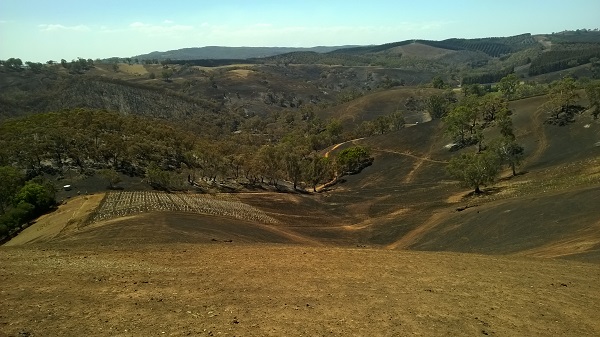
This is what we were greeted with 2 days after the fire ravaged our entire Mt Bera property. This is looking to the NW – where you can see the decimation of the Cudlee Creek Conservation Park across the Torrens River. This overlooks Little Mt Bera, and the Amphitheatre Vineyard. The vines directly in view were planted only 2 months earlier. The vineyard on the NW face to the right was planted the previous
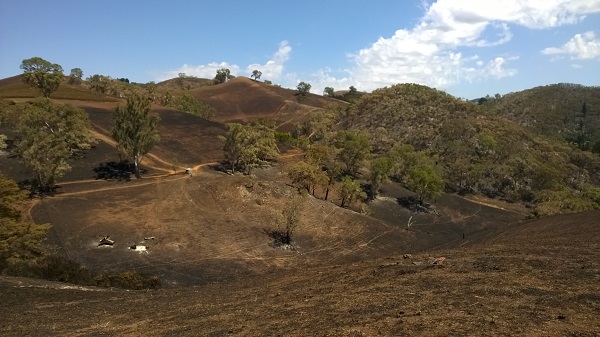
This is the view from the Northern Ridge of the Mt Bera property we call the Faraway Hill. Looking South with Little Mt Bera, and Mt Bera visible with the top of the Pinot Noir and Merlot vineyards on the left, the Amphitheatre in the middle and the Cab Sauv only slighly visible between the two Mt Bera humps over to the right.
The Amphitheatre Vineyards.
These are two separate faces within a massive natural amphitheatre. These two vineyards were our initial focus as the vines were young and we felt water was most important for them.
The NW face is very steep and has a huge elevation change betwen the top and the bottom of the vineyard. There are 3 watering blocks split into 3 elevation sections. The top 2 watering blocks were planted to Shiraz in 2013, and the bottom watering block to Blaufrankisch after the bushfire in 2015.
The NE face is planted to 2 clones of Pinot Noir in the top 2 watering blocks – which were only planted less than 2 months before the Sampson Flat fire decimated them. The bottom watering block was planted to Zweigelt later in 2015 after the fire.
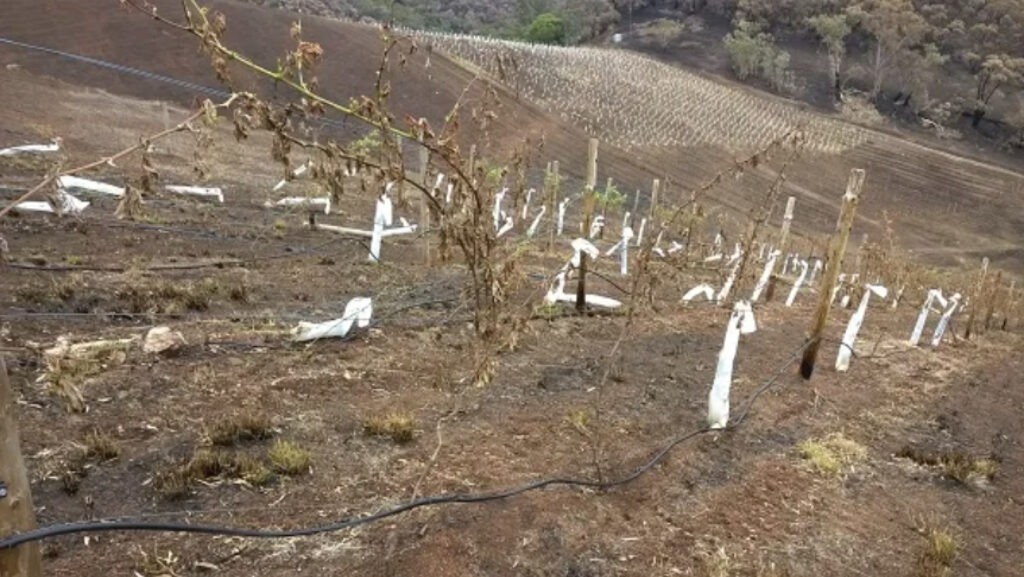
This is a view from high up in the Amphitheatre Shiraz block which runs down the NW face of the Amphitheatre. In the Background is the NE face which contains 2 clones of Pinot Noir. The Shiraz was planted late October 2013. The Pinot Noir was planted late October 2014 – only a couple of months before the Sampson Flat bushfire. The shiraz grew strongly and we were expecting some crop off it even though it was only the second season. The vines not strong enough to get to wrap on the wire were two-budded and had plastic guards on them – some which melted partially and others that went completely up in smoke or melted and burnt along the ground.
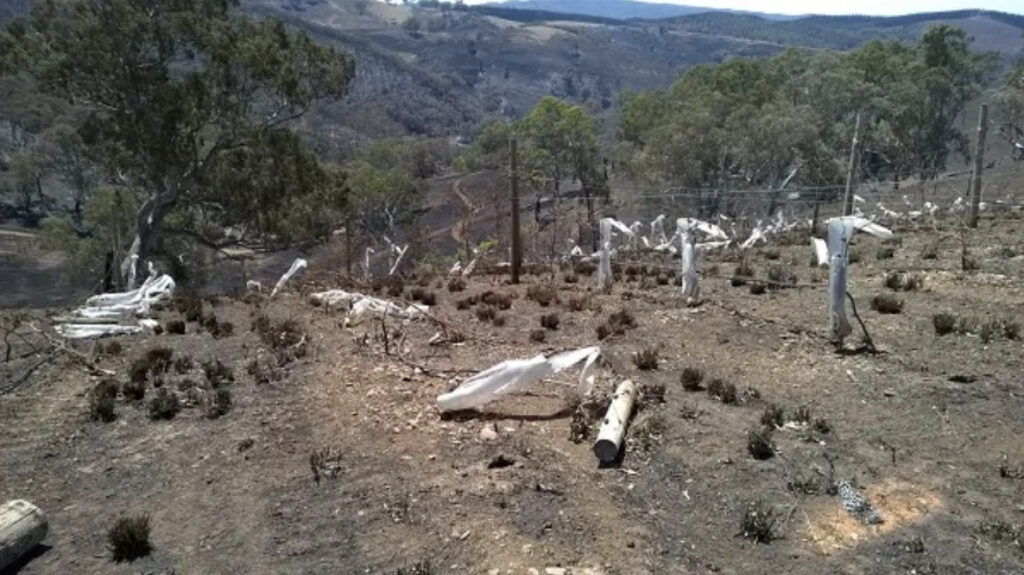
A view looking more to the North and down the Amphitheatre Shiraz vineyard. Loads of posts missing including strainer posts, and of course all the dripper tube gone.
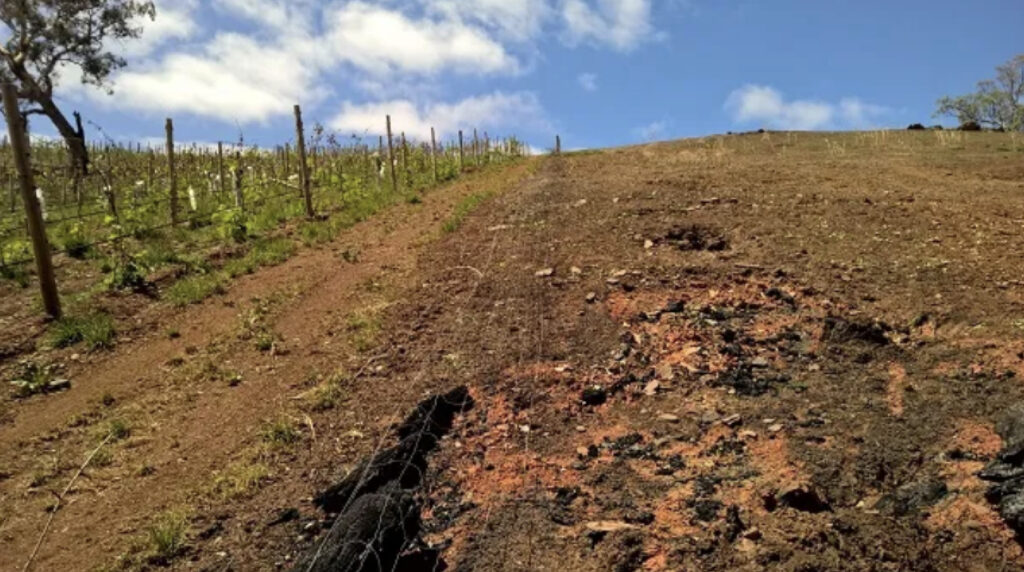
Here we are looking up the hill of the NW face of the Amphitheatre Vineyard. Shiraz vines were planted only 14 months before. A massive old dead redgum we loved and left just outside the vineyard all went up in smoke – including the beehive in it – and the heat burnt all the posts nearby and the vines and guards just upwind and uphill of it. This photo is taken on the 1st of March. We had restored all the posts in this vineyard and managed to get water back onto it around a month after the fire. As the vines were young we prioritised this vineyard. We did get some replacement vines as some were slower to reshoot from the ground than others – some of the vines we added had the original one come up a couple of months later. When digging down it was clear the top section of soil was so hot that the vine had to put out a new shoot from way down deep. In many cases where we thought the vine was not going to shoot, I dug down and found a new shoot coming from very deep that was just taking longer to get to the surface.
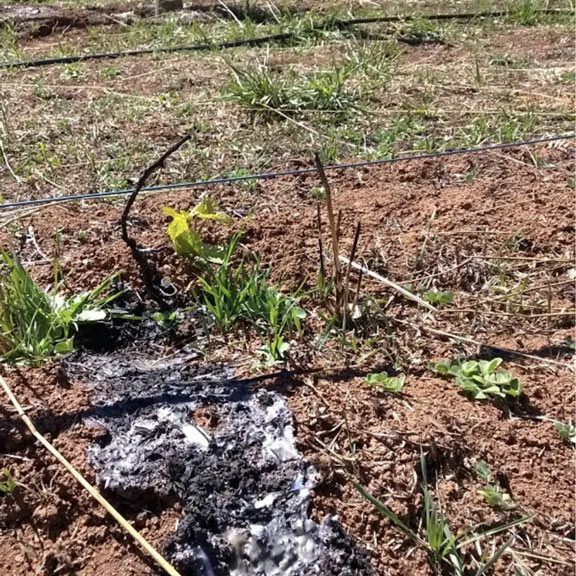
This is looking across near the top of the Amphitheatre Pinot Noir on the NE face. The heat was so bad that the guards were completely gone – leaving a trace over the ground – and the 2 month old vine was completely burnt with its charred remains still showing. However, even for something so badly burnt and damaged you can clearly see the new shoot coming through – and this photo is the 29th of January! We had not restored drippers in this vineyard yet either.
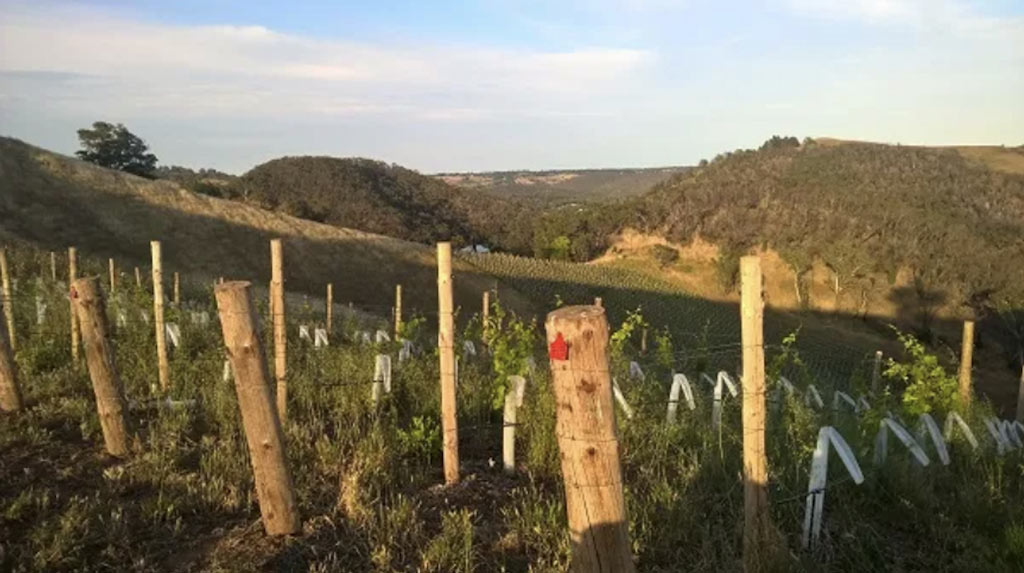
Fire? What fire? This is taken on the 25th of November 2015. This photo is looking from the top of the Amphitheatre Shiraz back over the Pinot Noir and Zweigelt with the Mt Bera homestead and Mt Bera itself behind. Hard to pick there has been a fire. On top of the vineyard rework we had waited several years to receive planting material for Blaufrankisch and Zweigelt – which of course was ready in Spring of 2015 – so we planted them as well after redoing all the infrastructure that had been put in place for them but not used.
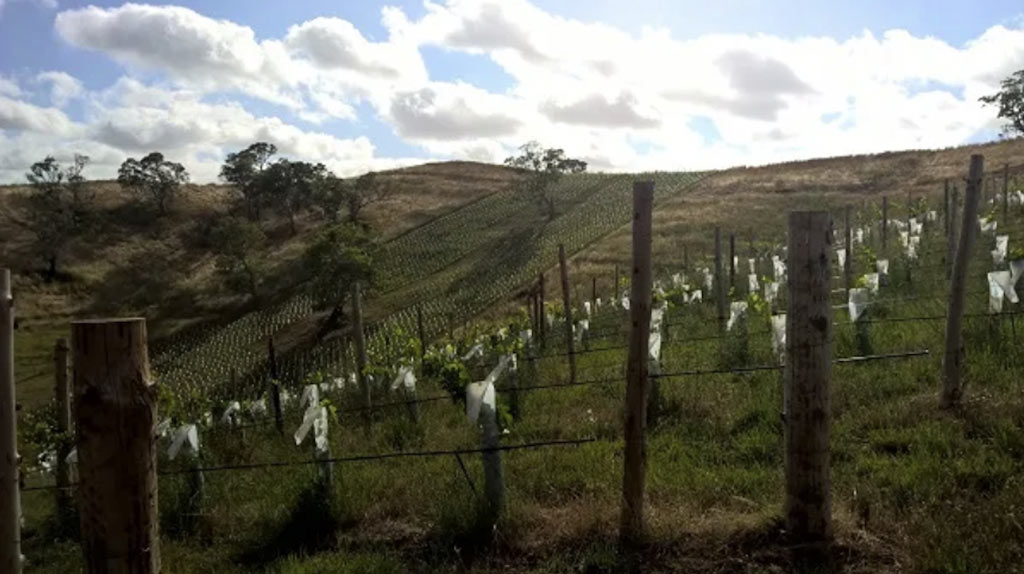
This is the next day on the 26th of November 2015. Here we are looking from the side of the Amphitheatre Pinot Noir over to the Shiraz on the NW face. What a magic sight it is too. Photos don’t do justice to how stunning this area is. The combination of the acoustics of the natural amphitheatre and the topography with far ranging visibility are just out of this world
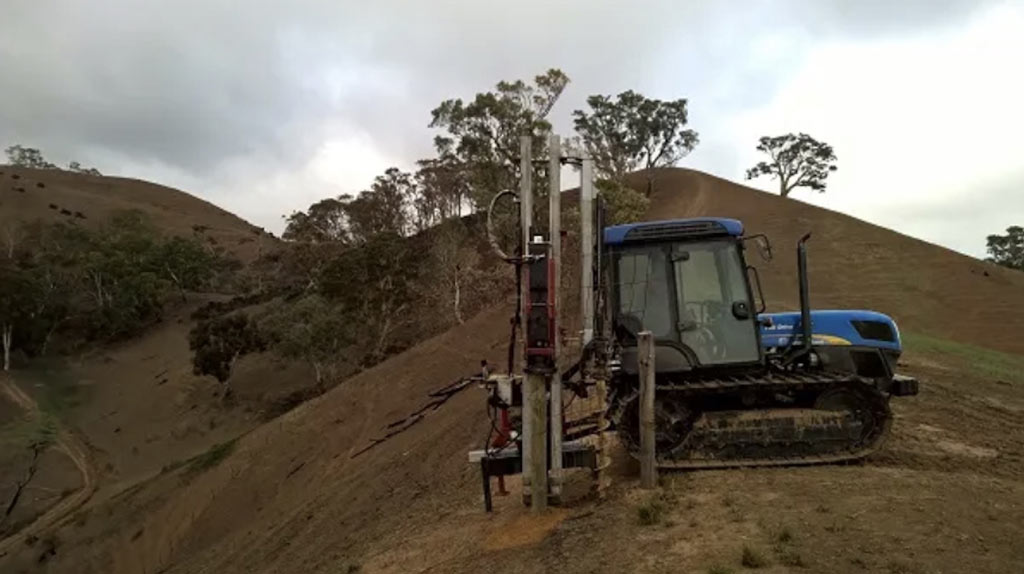
This is the next day on the 26th of November 2015. Here we are looking from the side of the Amphitheatre Pinot Noir over to the Shiraz on the NW face. What a magic sight it is too. Photos don’t do justice to how stunning this area is. The combination of the acoustics of the natural amphitheatre and the topography with far ranging visibility are just out of this world
Retreat Vally Road Vineyards.
This is broken into different sections due to the topography, grape variety, and root system.
- Pinot Noir Saddle Block. Completely burnt. See below.
- Pinot Noir Short Rows. Partially burnt. Badly in some places and not as bad in others. Trained new shoots from the ground over 3 years whilst getting a crop still.
- Pinot Noir Extension Rows. Completely burnt. As per Saddle Block.
- Merlot Top Block. Completely burnt. As per Saddle Block.
- Merlot Bottom Block. Partially burnt. Still spur pruned and good crop despite some fairly heavy burns around the trunks.
- Tempranillo. Grafted onto Merlot roots in the bottom block. Own discussion down below.
- Shiraz. Grafted onto Merlot roots at the top of the bottom block. Same as per Tempranillo but not as badly burnt.
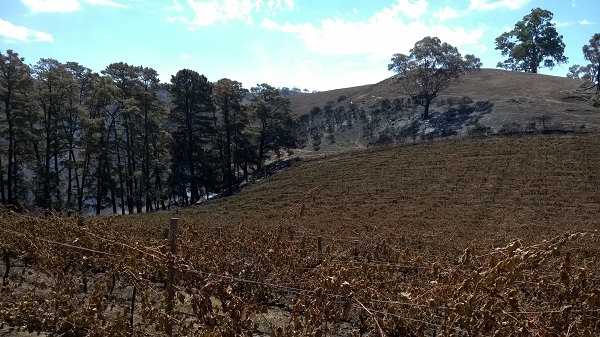
This is looking across the Saddle Block of Pinot Noir to the NW. The key thing to note here is the row of about 80 Radiata Pines running along the end of the rows. They appear to have been planted in the early 50’s. A fantastic source of scorching radiant heat! Everything within visible sight of them was completely nuked. There were no strainer posts left and nearly every post in sight was also gone. If you have them near your vineyard or orchard I would recommend getting rid of them as soon as possible. The Pinot Noir vines were planted in the late 90’s, so were approaching 20 years old. All planted on own roots thankfully (while Phylloxera is not yet in SA)
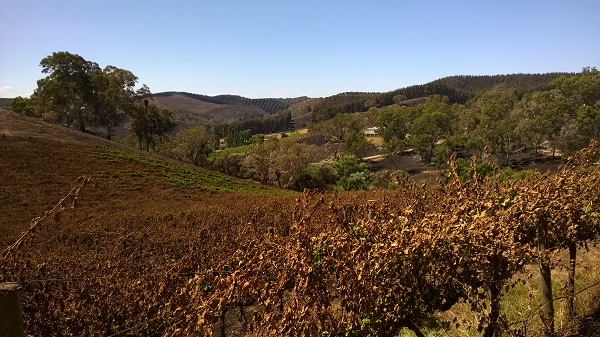
Looking at roughly 90 degrees to the previous image towards the North you can see a small amount of green in the canopy once on the leeward side of the hill away from the pine trees.
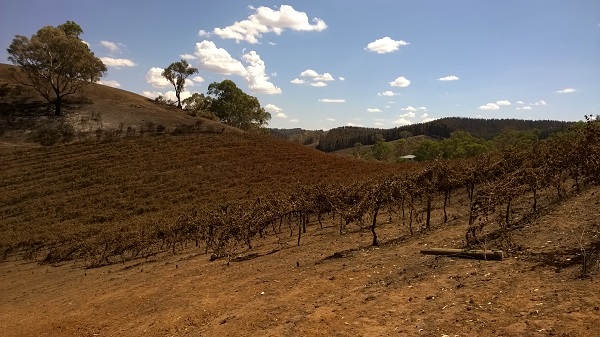
This is a closer view of the Pinot Noir from the pine tree end. No strainer posts. Almost no posts remaining. Completely nuked vines. Ground burnt down a foot deep at the ends of the rows near the pines. Based on the AWRI talk about the vineyard that had been burnt in Victoria we thought we would have to start again and replant. This proved not to be the case and the key thing here was that they didn’t try cutting the vines off in that example – it was completely missed out in the discussion.
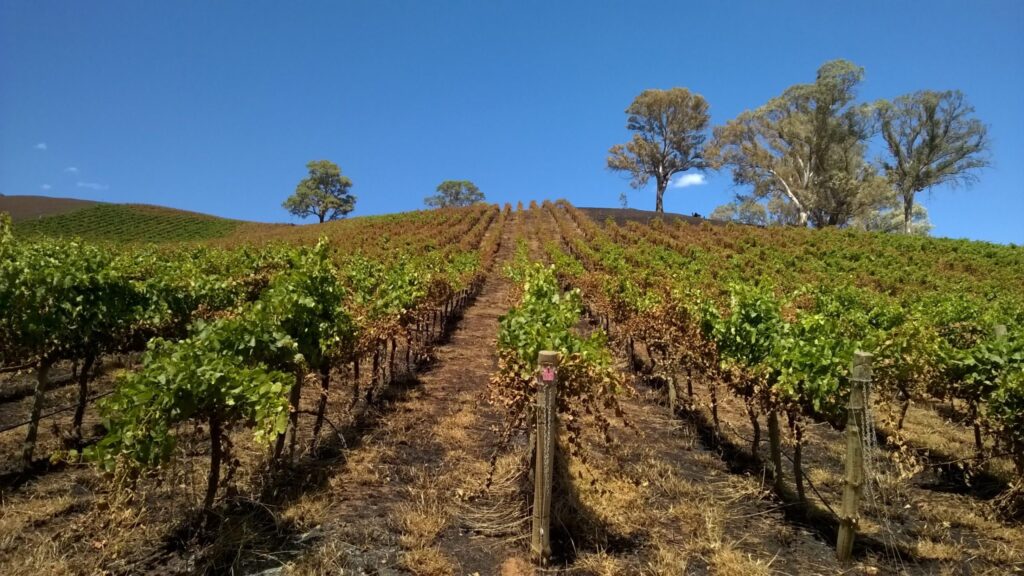
This is the view from Retreat Valley Rd looking up the Hill. To the right the Short Rows are Pinot Noir. Then there is a section of extension rows of Pinot Noir, going right up over the hill, then on the left of the hill is Merlot. The fire came from over the hill to the right with enormous heat from the conservation park, and our undergrazed land with grass a metre tall sadly. These rows are oriented NE/SW and the fire came from the North West.
A few observations. The vines at the top of the hills were nuked. On the leeward side of the hill the fire was not as ravaging – as you would expect. As we were planting a new vineyard in the Amphitheatre we had not mowed the grass in the vineyard as well as we could have. We are organic and do not spray undervine – which is great for soil biology, plant health and nutrient recycling – but not so great in a fire. We use a Fischer undervine mower which does a reasonable job where the vine rows are not terraced, and the trunks are old enough and vertical enough for the sensor bar to work properly.
Due to practicalities we just didn’t have the resources to be able to do all the vineyards as we may have. We also had the issue of needing some fruit still for our own wine label even if we couldn’t provide to Penfolds.
I will come back to it later but in summary. The Short Rows of Pinot Noir to the right of this image were left untouched. You can clearly see how much burning was around the trunks though. We ended up training new water shoots up over several years then removing the old vines. In the meantime though we were able to get a decent crop of grapes and the general rule of thumb seemed to be that the vine could generally produce a full crop with up to 50% trunk functioning. Once past 75% of the trunk burnt then the crop level was reduced, and the new shoots would either come from the ground or from a section of trunk that was still functioning. For 100% damaged trunk the vine shot a water shoot from the ground to tell us the old trunk was useless. Our preference in all situations was to eventually get to have a new shoot from the ground rather than use a shoot with potentially degraded flow capacity.
The Extension Block of Pinot Noir was nuked so it was beheaded at its ankles.
The Merlot has two watering blocks. To the left of the image you can see green. This was in the lower watering block on the leeward side of the hill. Partially burnt, but we left this watering block untouched. The top watering block was nuked so we beheaded at the ankles also and joined the cordon wire in. When looking closely at the lower Merlot Block you would perhaps have been tempted to behead it too, but to this day we have not reworked it and nearly every vine has produced to full capacity ever since the fire.
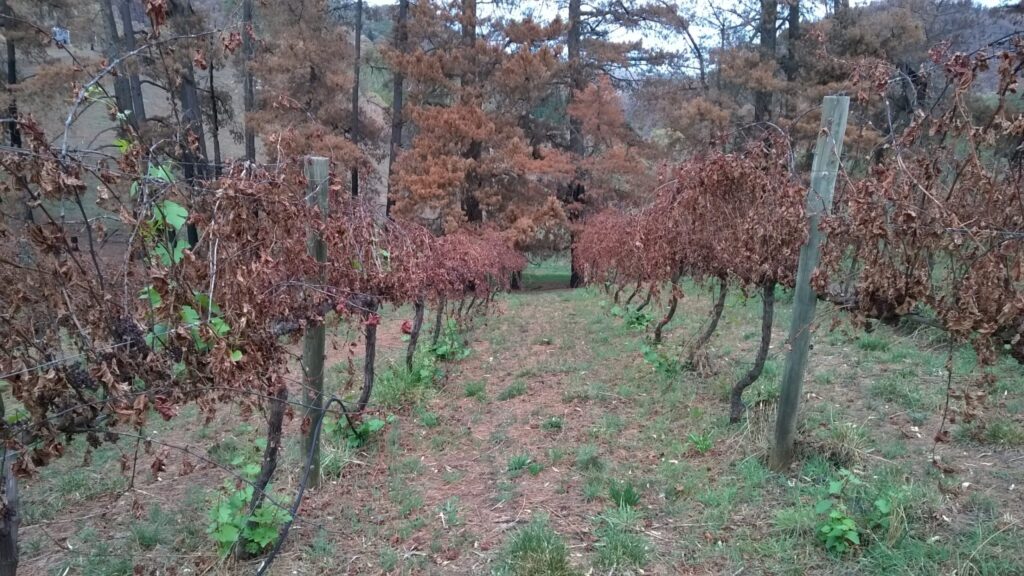
Here is the Pinot Noir Saddle Block on the 14th of February 2015. 6 weeks after the fire. No irrigation on. The issue with this vineyard was the pine trees. There was no point doing anything until we could remove them or they would land on the vineyard and break all the repair work.
What this clearly shows is that despite the extraordinary heat that these vines, and the soil, were exposed to – and everything above ground being dead – the 20 year old root system was alive and well, pushing out new shoots. Some came later than others but from digging down this was due to the location where the vine could form a new shoot. The deeper the location the longer it took to get to the surface.
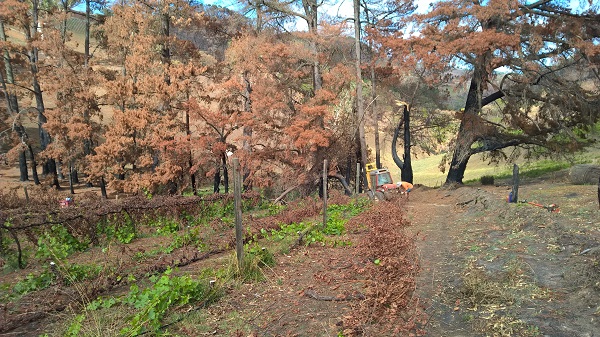
Another 3 weeks later. The Pinot Noir vines shot multitudes of shoots from the ground. We had no resources to be able to remove all the dead wood quickly enough or to get the pine trees out to get the infrastructure back. The end result was that we left all the bush growing from the ground then at winter pruning we went back to 2 shoots and 2 budded them. This allowed some insurance so we could get a big enough pipe for the second years crop – as in by having 2 trunks half the number of grapes needed to be ripened by each trunk. We ended up with about 80% of a desired crop level in 2017 – I won’t say a normal crop as there is no such thing as normal…
In the third year after the fire we picked the best shoot to be a single trunk and had a full crop.
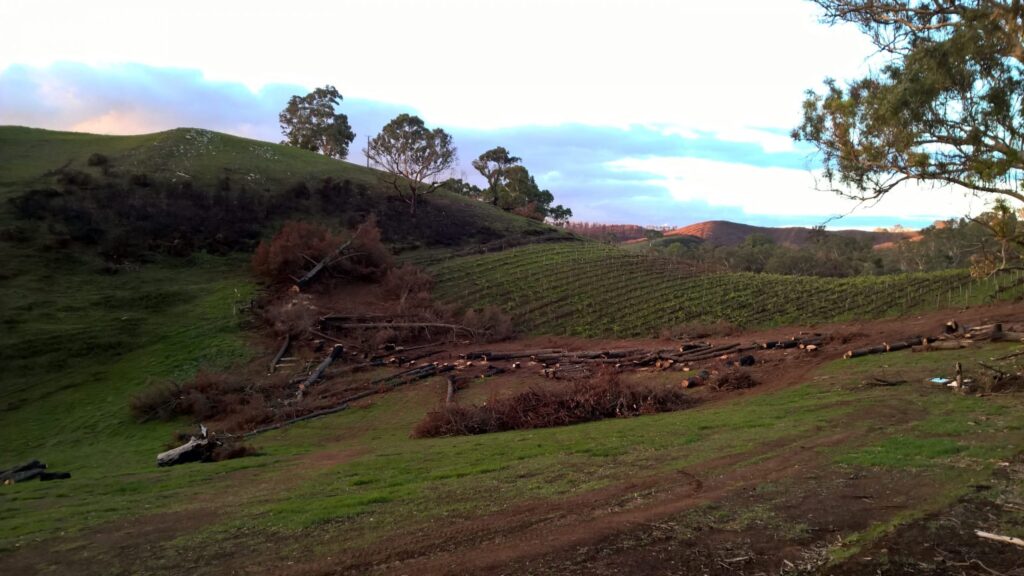
You can’t believe how much of a boost this gave us – seeing all the burnt Pine Trees on the ground. Lots of work still for us to cut off all the limbs and throw them on bonfires, but speaking of small wins this was a psychological boost of amazing proportions. This is the 27th of April 2015. Nearly 4 months after the fire to get to here.
Finding someone to cut down the trees was not an easy process. We were hoping the government entities could help out – even to be paid – such as SA Forestry who have all the capability – but they said they could not help or do any external work. Perhaps the governments could think about assisting in this regard. After some ridiculous quotes we found someone who cut the trees down on the condition that we would assist with our tractor loading up a mobile saw mill so he could sell sleepers. We had to clear away the rubbish but the deal worked out well for both of us. While he was there we took the opportunity to also have him mill up some massive redgum that didn’t go up in smoke. The new toilet block at the Mt Bera Cellar Door use the slabs for the wash basin benches.
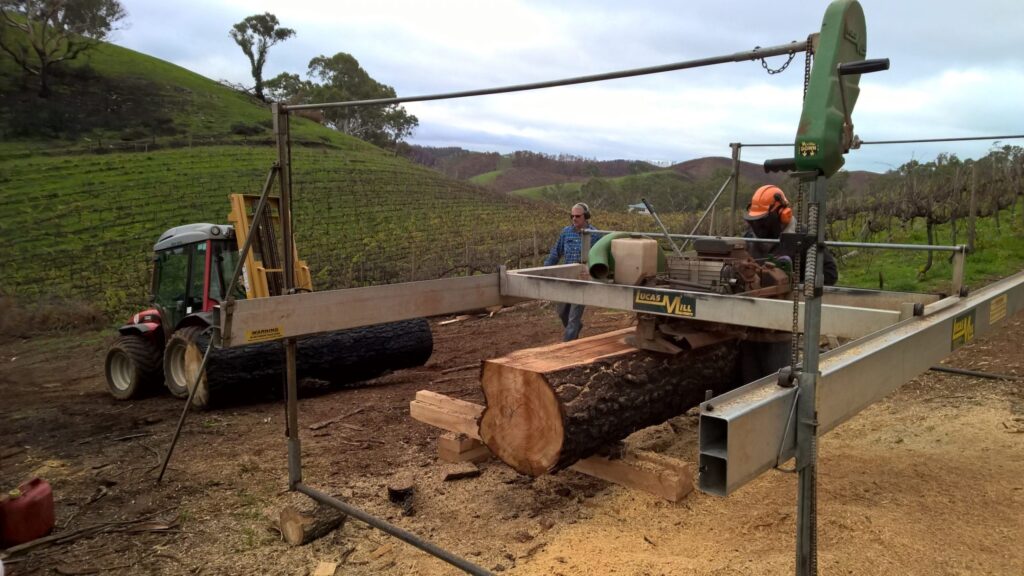
The mobile saw mill removing the pine trees from the end of the Pinot Noir.
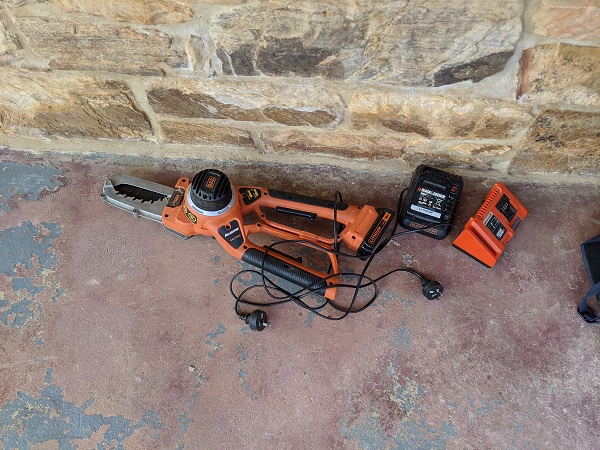
Initially I was cutting out the vines with a normal chain saw. Until I hurt my back. Before then with so many posts missing and wire everwhere it was difficult and dangerous as it was easy to either hit the dirt and blunt the chainsaw or hit some wire doing the same and tangling it up.
A friend suggested the Black and Decker Alligator, and at first I thought it would not be up to it, but it was the best purchase ever. One battery would do between 50 and 80 vines depending on how burnt they were. Katrina or one of the kids would paint the stump and we could do a row or so each set of 3 batteries then start throwing the charred vines on the trailer and building the bonfires. With 2 hands. Light. Quiet. A short chain and easy to draw the chainsaw back out from under the vine with nothing supporting the top. I cut off more than 15,000 vines without even sharpening it. With the guards you can get in behind a new watershoot or avoid wire. Being battery operated it stops when you aren’t cutting. It also draws itself through the trunk. Seriously I don’t think I have bought many items better than this one.
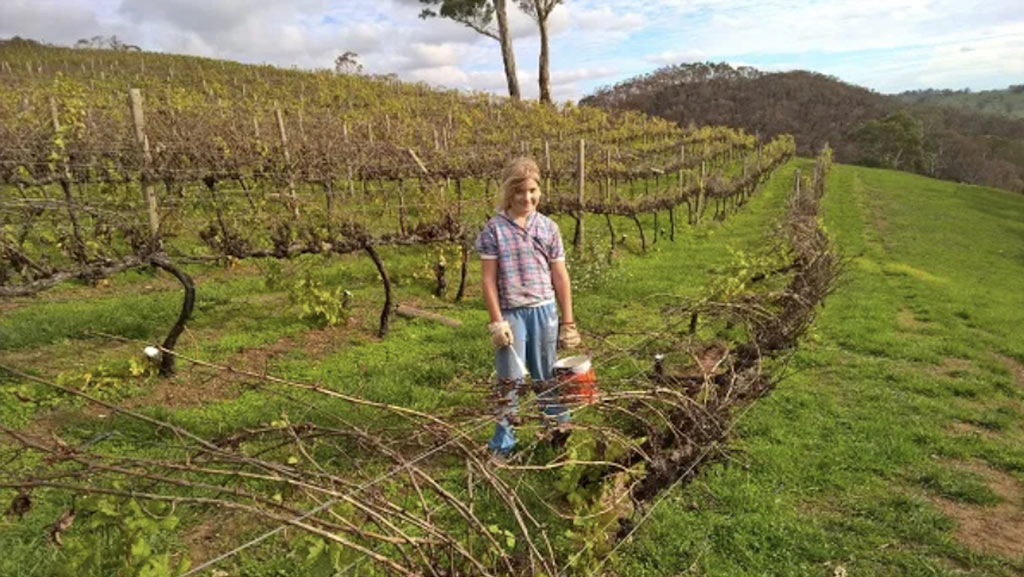
The vine top removal was a slow but methodical process. After cutting the vines off just above ground level Katrina or one of the kids would paint the stumps. This is Maya, our 10 year old at the time, doing the paint job.
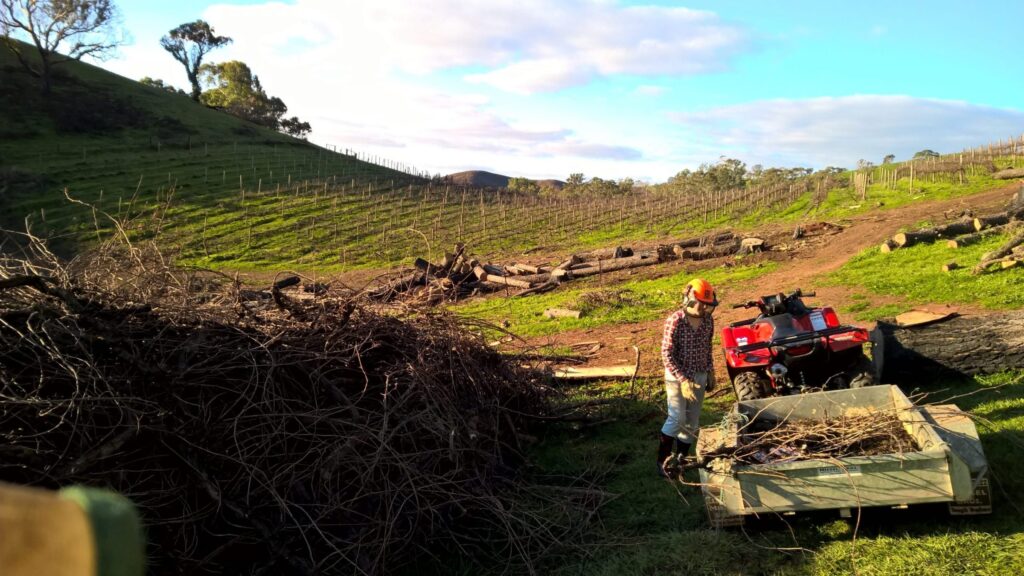
Building the bonfire. We cleared out the scorched dead vine material with the quad bike and trailer. Most of the removal work was done during the school holidays when the kids were available to help. This is Lily unloading the trailer on the 19th of July 2015.
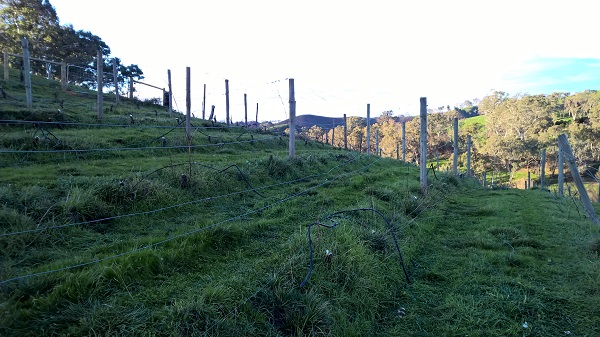
A section of vines with their heads taken away. A welcome site but lots more to go. This photo is the 19th of July 2015. No irrigation drippers yet…
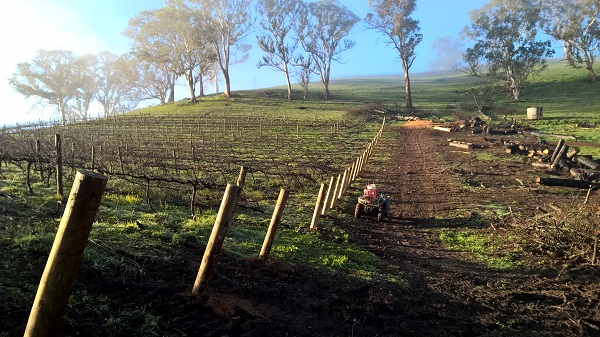
At long last. Another major milestone. The strainers all in at the pine tree end of the Pinot Noir saddle block. This is 23rd of July 2015.

3rd of October 2015. The bonfire pile grows as the vineyard gets cleaned out. Luka on the pile.
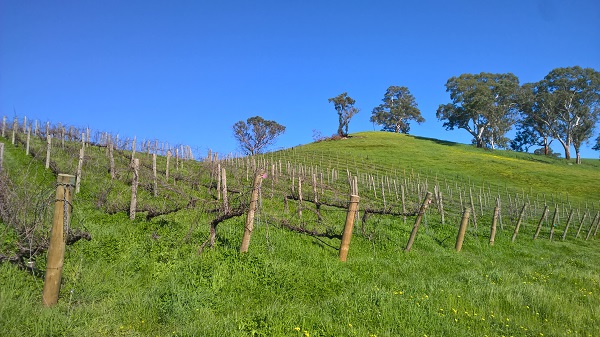
25th of September and still going with the old vine removal.
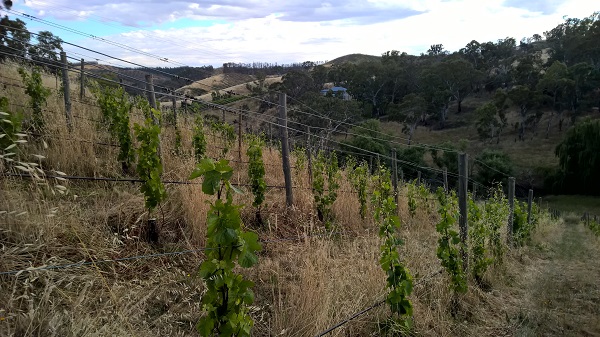
30th of November. Irrigation back in. This is the regrowth of the Pinot Noir. Note most of them have 2 canes growing up as I mentioned earlier to allow enough pipe for the vine to produce a decent crop – but more training passes to come as the vines continually pushed out new shoots. Every single vine reshot – no matter how badly Nuked they had been.
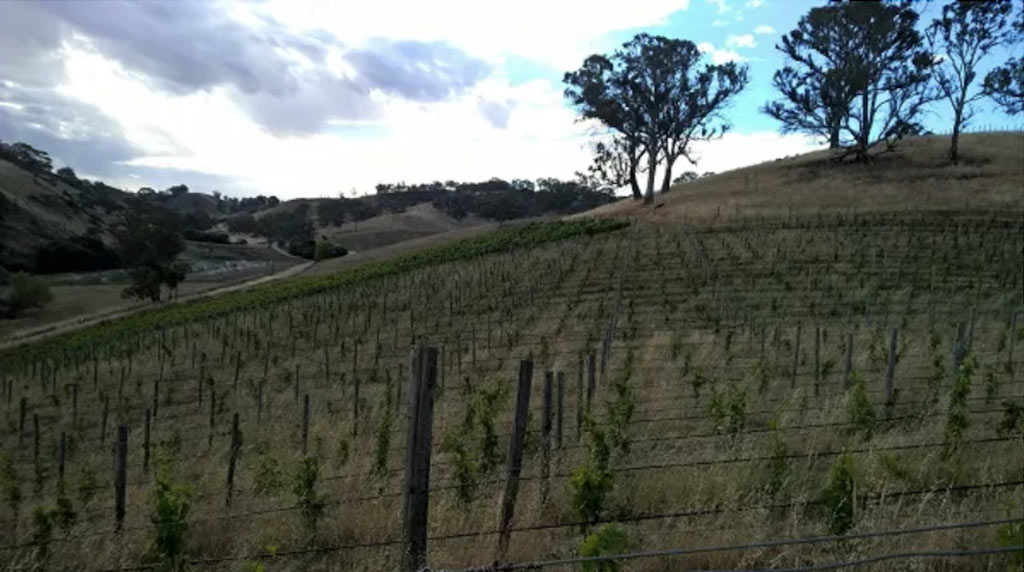
30th November 2015. View along Retreat Valley Rd to the South East. Saddle block in the foreground with every vine reshooting. The Short Rows are behind them. The Short Rows were not beheaded but spur pruned as normal and despite the burnt trunks seen in the picture earlier we found – loosely – that up to 50% of the circumference burnt could produce a full crop. Once it went past 75% the shoot growth tended to be stunted. Above 90% and the vine told us clearly by rapidly shooting a new shoot from the ground. We allowed all vines to leave a single shoot from the ground whilst we obtained a crop from the burnt vines. In 2018 we beheaded the remaining Pinot Noir in the Short Rows and had almost a full crop from the newly wrapped down canes from the trunks grown over the previous 3 seasons.
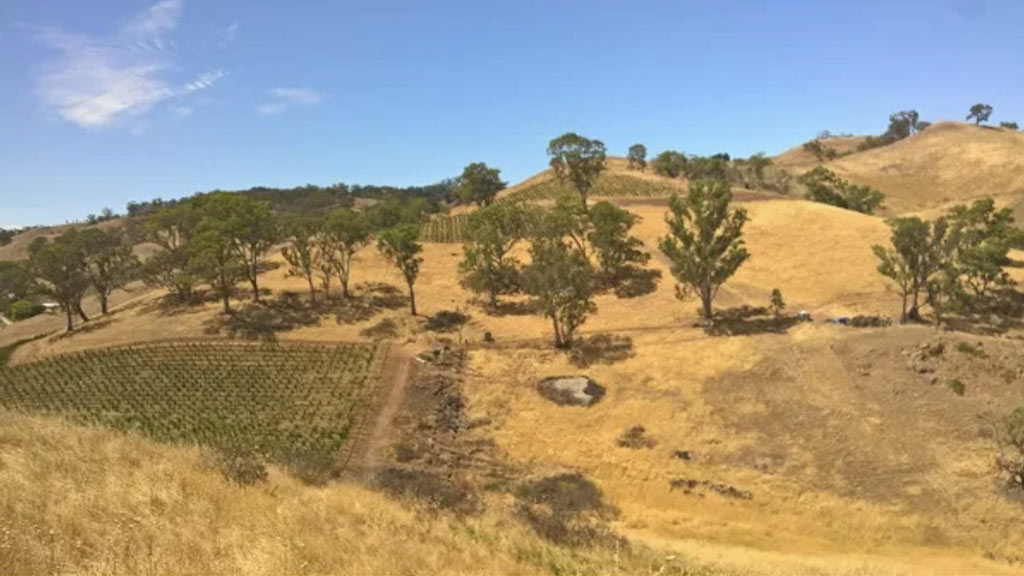
31st of December 2015. Almost a year on from the Sampson Flat bushfire. This view is from the Faraway Hill looking over the Saddle Pinot Noir showing all the regrowth. Up on the ridge just behind is the Extension Pinot Noir. All beheaded and growing back. The final block behind is the Top Merlot. Also beheaded and all growing back.
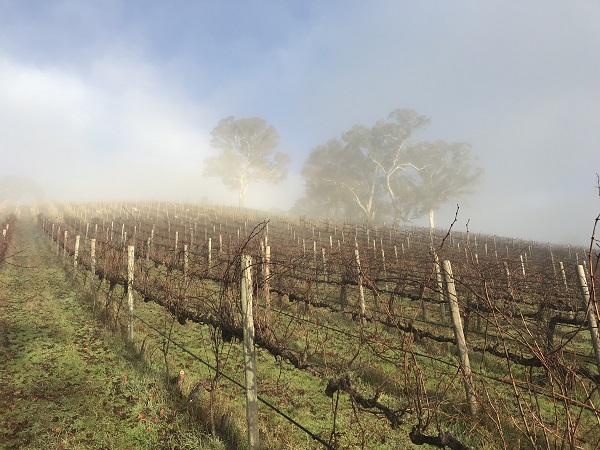
Pinot Noir. Short Rows. June 2018. After getting close to a full crop from the quite burnt Pinot Noir short rows, we finally beheaded them in June 2018 after training a new shoot from the ground, and enough growth to wrap down new canes to get almost a full crop from the new trunks.
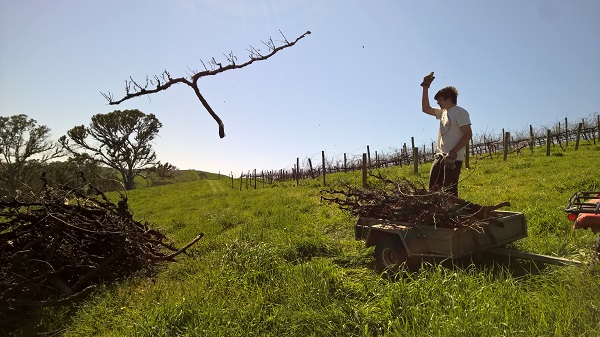
Luka with another old vine biting the dust.
Retreat Valley Road Bottom Block.
This has about 1/2 a hectare of Shiraz grafted onto Merlot rootstock, plus about 1.6 hectares of Tempranillo grafted onto Merlot rootstock, and about 1/2 a hectare of Merlot on own roots.
As this is about the flattest bit of land on our property the fire slowly meandered through here in no particular way with randomly burnt vines. Trunk damage was severe where the fire was worse and in other areas trunks were only partially burnt. Due to the relatively long grass undervine the cordons were also scorched. This meant that this vineyard was the most variable, and because it was grafted it was the most difficult to deal with.
The steps we took were.
- Vines that were shooting from the ground indicated a lack of above ground vine function. We left all shoots until winter and chose only one shoot to train up as a new trunk which we intended to regraft.
- If the cordon was burnt but the trunk looked acceptable we tried to leave a few buds near the graft if possible to shoot out and rewrap down. If they produced full strength shoots then it was left to use as the new cordon.
- If the shoots up the top were only short and not growing fully then generally there was a shoot from the ground anyway to indicate the top was too damaged. Retraining of a new trunk and regraft.
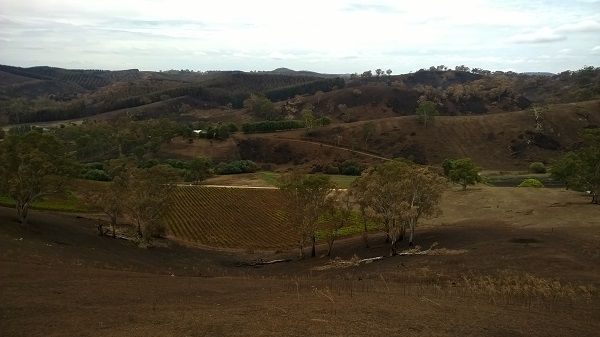
This is overlooking the bottom block in the Retreat Valley Rd vineyard.
Shiraz has some slight green to it on the right.
Tempranillo has not a lot of green.
Merlot on own roots on the left of the bottom block doesn’t have a lot of green either.
Temptation would be to cut these all out, but as they were grafted it didn’t make sense to – apart from the fact we just didn’t have time to anyway. I have seen many vineyards in the recent fires nowhere near as badly burnt as these. About 2/3 of the vines remained functioning, although quite a lot of cordons had to be removed back to near the graft, as they had been burnt too, due to the long grass.

A closer shot of the damage in the grafted sections of the vineyard – Shiraz in the foreground and Tempranillo below. The black around the trunks gives away the grass that was there beforehand. None of these vines were taken out, until individual vines proved that there was no life above and so we retrained new shoots and regrafted after the new trunk was large enough.

This is taken on the 30th of November 2015. You can see the moth eaten section of Tempranillo down in the lower sections, but we still had a decent crop of Shiraz and Tempranillo for Vintage 2016, while the moth eaten sections reshot a new trunk for future grafting.
Top Merlot Block.
This block is 2 watering blocks – one at the higher elevation which was nuked, so beheaded.
The lower watering block we left untouched and it has not been reworked apart from the odd vine that was not functioning.
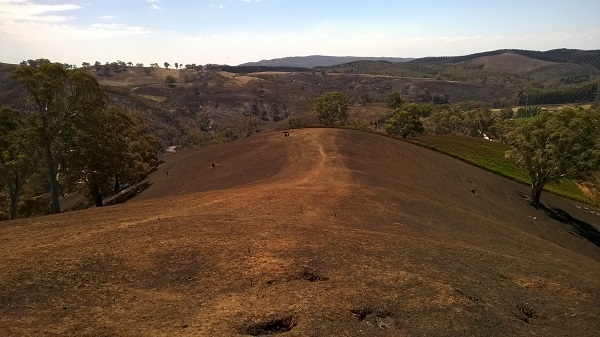
Top Merlot looking North. See the green section in the lower watering block.
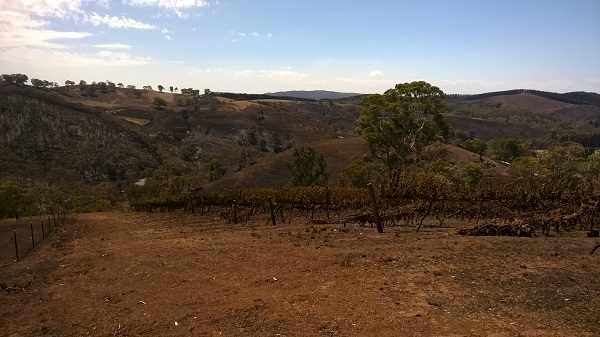
Top Merlot. Close Up. Looking North.
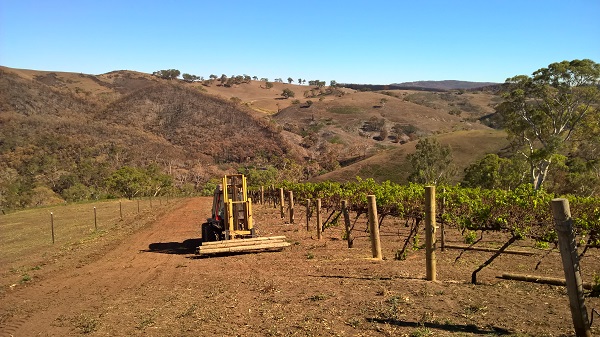
Top Merlot. Close Up. Looking North.
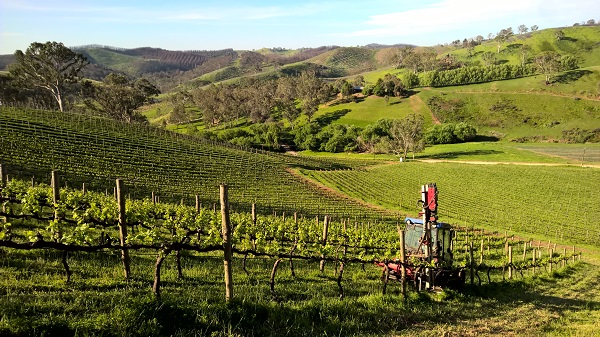
11th of October 2015. Overlooking the lower section of the Top Merlot. This section was not reworked.
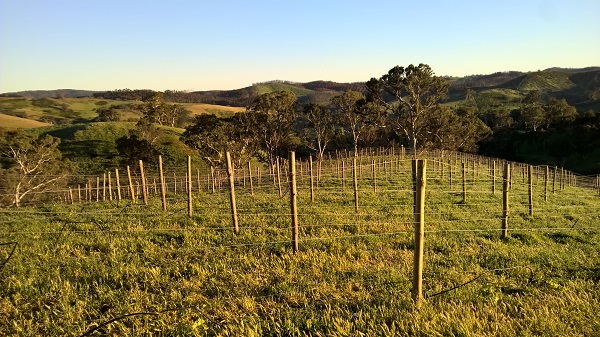
14th of October. Are there vines under here? This is the Top Merlot top watering block all beheaded.
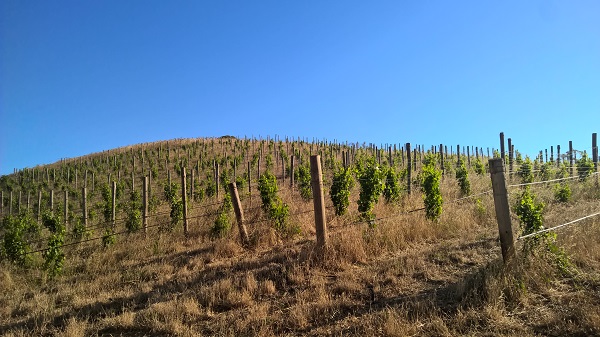
23rd of December 2015. Almost a year on and the whole Top Merlot block that was beheaded has reshot and up to the wire.
House Vineyard.
This has Gruner Veltliner in the lower sections of the valley, and Cabernet Sauvignon on the warmer slopes.
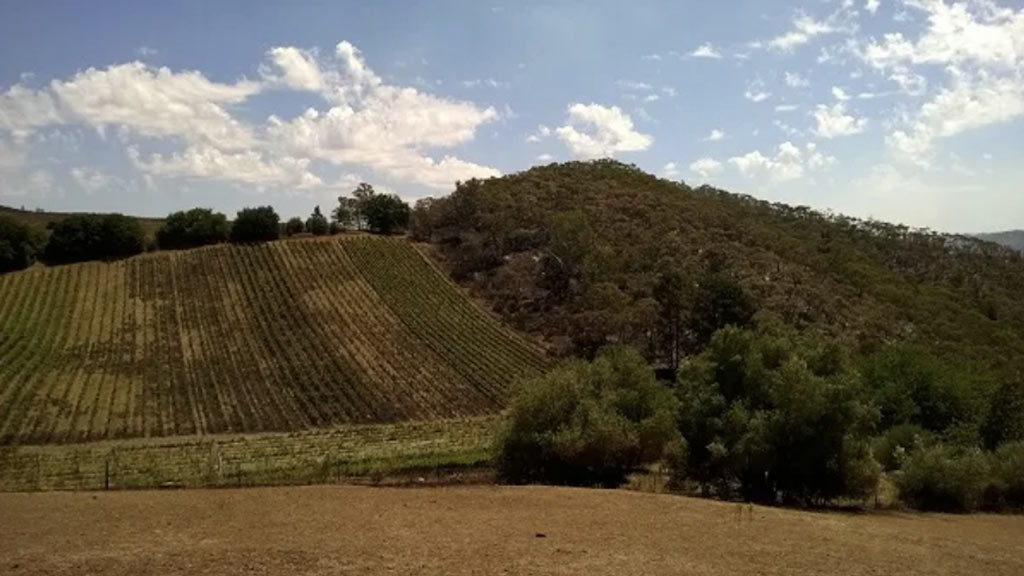
Overlooking the Cab Sauv Hill block. You can see the meandering burns through this vineyard. We were sequentially reworking this vineyard for Eutypa so there were different ages of vines. The fire here burnt across from the main fire front and was not as fericious as the other vineyards.
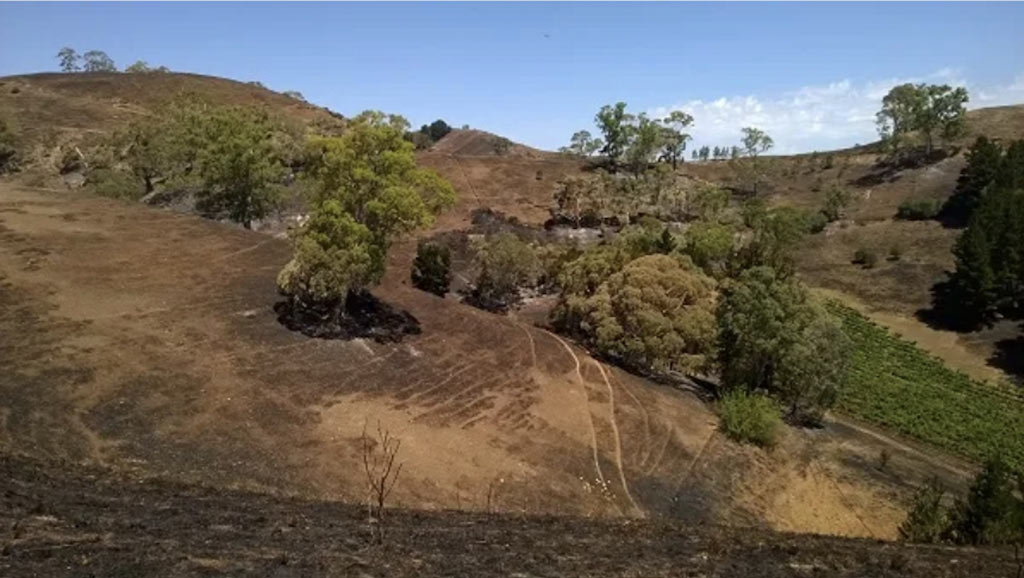
Overlooking the top of the section of grafted Gruner Veltliner – onto Cab Sauv. The fire came up around the dam and then the fire wanted to go uphill so didn’t burn most of the Gruner Veltliner. It was going to be our first decent crop of Gruner, and we were excited to see the grape bunches throughout the Gruner. However, after doing some sampling we were done with smoke taint – the delicious taste of ashtray!
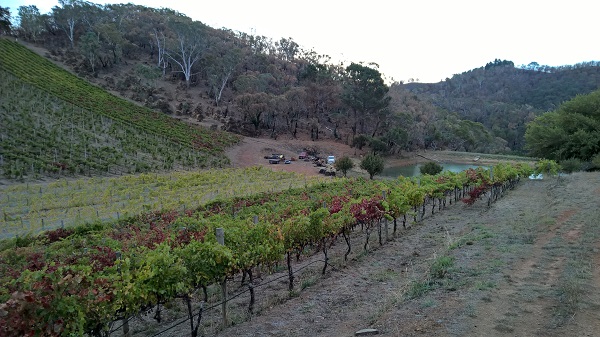
This is taken on the 4th of April 2015. Three months after the fire. The red vines were those with quite severed burns around the trunk restricting sap flow. They were beheaded.
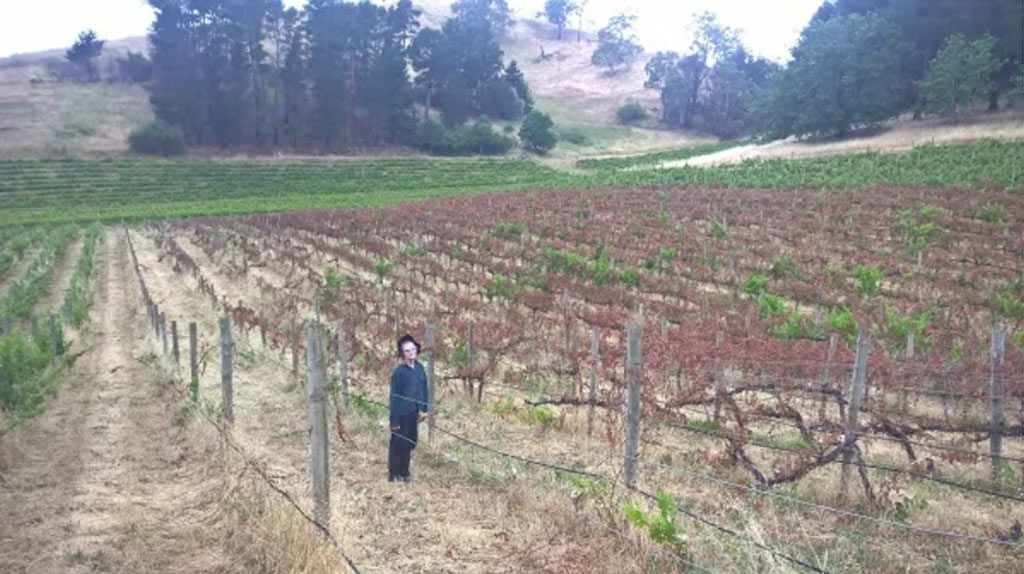
Kali helping out removing the beheaded Cab Sauv. We decided in the end to accelerate our Eutypa treatment program and finish off all the Cab Sauv that had not been done – and remove the burnt trunks at the same time. This photo is taken the 25th of November 2015.
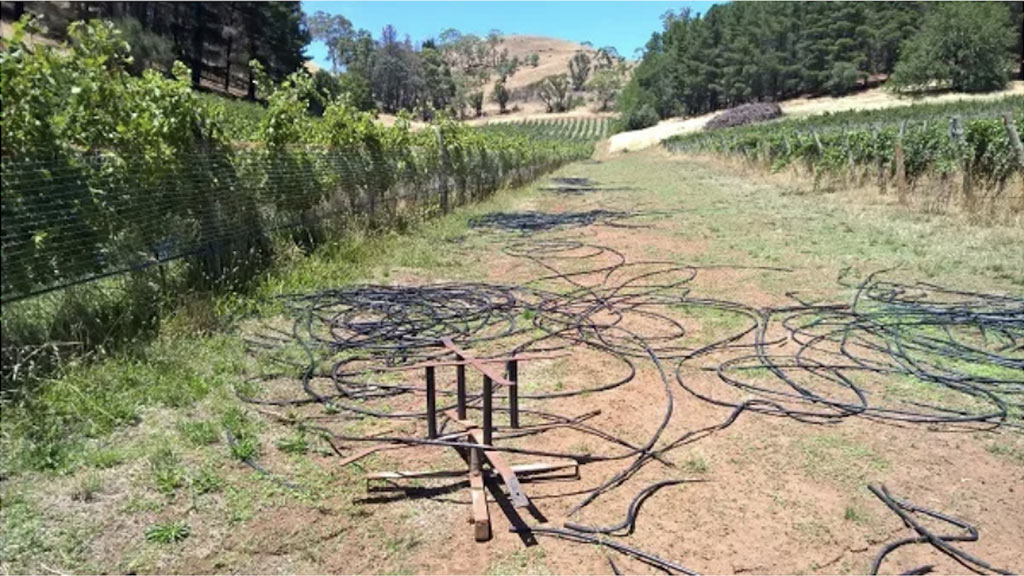
After reworking all the dripper lines everywhere else we finally got to replacing the burnt dripper lines in the Cab Sauv. This photo is the 7th of February 2016 – over a year since the fire and no water back on the vines yet. It could have done with water earlier but we didn’t have enough water to go around anyway in a dry season.
The Cab Sauv was the only vineyard where there were vines that didn’t reshoot from the ground. We think it was a combination of Eutypa Lata getting down the trunk too far, combined with the fire being the last straw.
